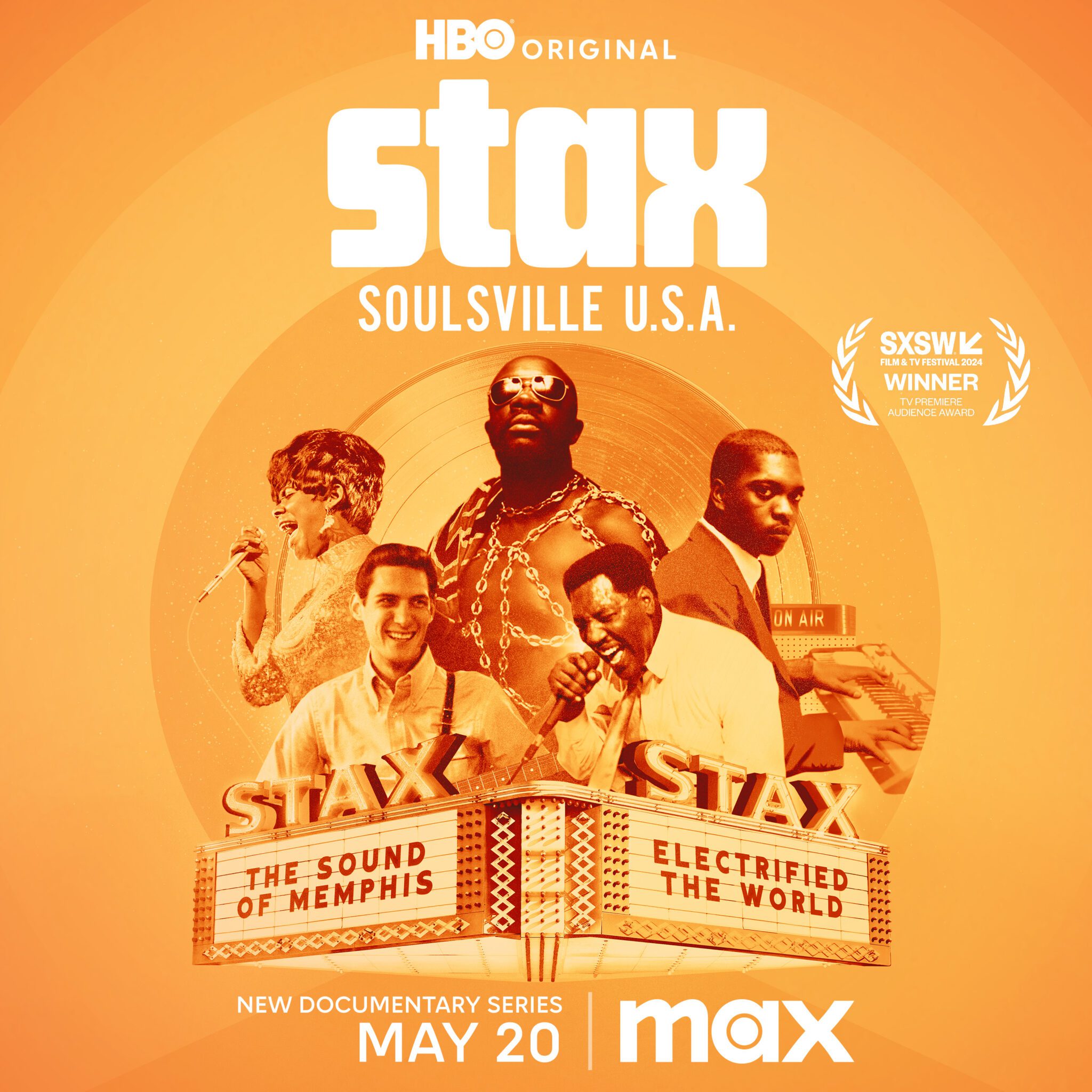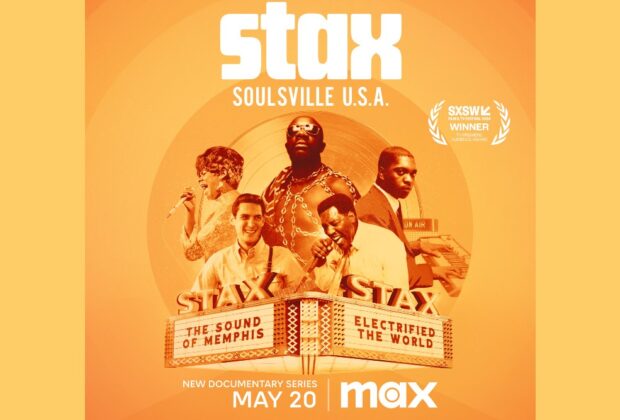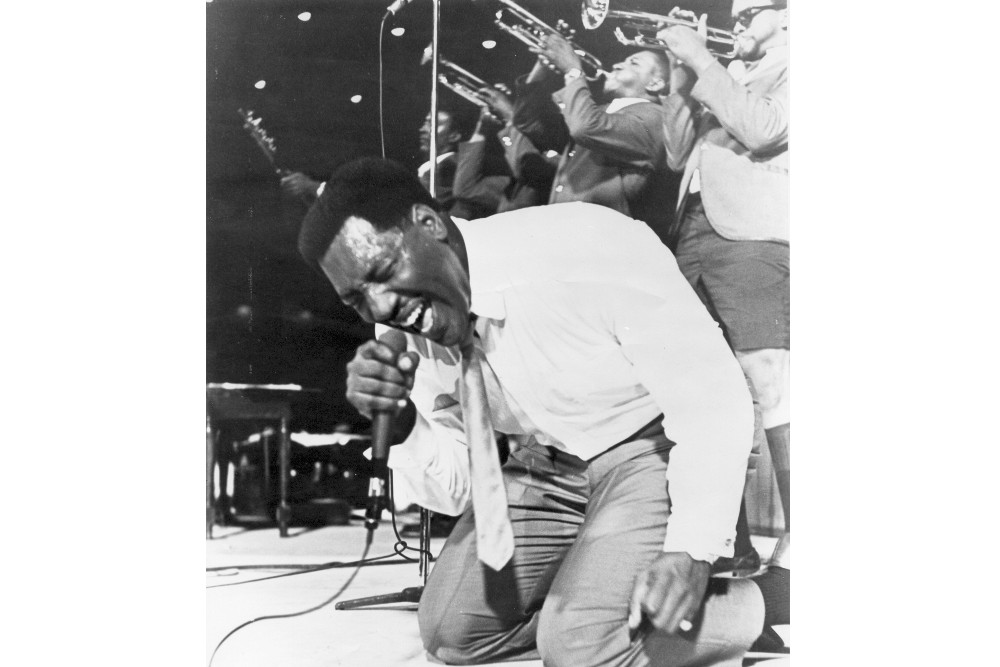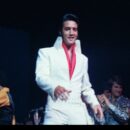The HBO Original four-part documentary series STAX: SOULSVILLE U.S.A., an official selection of the 2024 SXSWFilm & TV Festival and winner of the TV Premiere Audience Award, is produced and directed by filmmaker Jamila Wignot.
The series, a production of Laylow Pictures and White Horse Pictures in association with Concord Originals, Polygram Entertainment, and Warner Music Entertainment, debuts MONDAY, MAY 20 (9:00-10:00 p.m. ET/PT) on HBO with two episodes airing back-to-back, followed by the final two episodes airing back-to-back on Tuesday, May 21 at the same time. All four episodes of the series will be available to stream on Max on May 20.
HBO Documentary Films presents STAX: SOULSVILLE U.S.A., a Laylow Pictures Production and a White Horse Pictures Production in association with Concord Originals, Polygram Entertainment, and Warner Music Entertainment. Directed by Jamila Wignot; produced by Jamila Wignot and Kara Elverson; executive produced by Ezra Edelman, Caroline Waterlow, Nigel Sinclair, Nicholas Ferrall, Scott Pascucci, Sophia Dilley, Michele Smith, Jody Gerson, David Blackman, Charlie Cohen, and Ron Broitman. For HBO: executive producers, Nancy Abraham, Lisa Heller, and Tina Nguyen.
In the 1960-1975 period the Stax company placed more than 167 hit songs in the Top 100 on the pop charts, and 243 hits in the Top 100 R&B charts.
Stax launched and/or further supported the careers of such legendary artists as Otis Redding, Sam & Dave, Rufus & Carla Thomas, Johnnie Taylor, Isaac Hayes, Booker T. & the MGs, Steve Cropper, Ron Capone, Albert King and numerous others.
Wayne Jackson was an R&B musician who played trumpet in the Mar-Keys and in the studio house band at Stax Records. Jackson later was a member of the Memphis Horns.
In 2007 Jackson and I discussed the epic Stax/Volt ’67 UK/Europe tour and Stax label memories.
“Initially it was going to be Otis and his guys who went on the road with him. It was Jerry Wexler who said, ‘No. They want to hear the sound of Stax.’ The UK audience knew it as the Stax/Volt band. The Mar-Keys and Booker T. & the MG’s that made up the band. They loved Otis Redding like we all loved Otis Redding but the band at Stax was the diving board he jumped off of.
“You can tell the horn sound,” Jackson reiterated. “Me, Andrew Love and Floyd Newman sound a certain way. All those records had that in common. All those records had Steve Cropper’s guitar, Al Jackson’s drums, Duck Dunn’s bass and Booker’s organ. Those things are very distinctive and that made up Stax sounds. And that’s where Otis came from. So, Jerry Wexler was really hip to say that,” Jackson remarked.
“I loved Otis and he loved me. We were big friends. ‘Cause we all liked to laugh, and we were all young and the testosterone levels were out of this world. That’s what you heard in that music. Al Jackson was a joy to watch. He was the most fun drummer I ever was around. He was just the best drummer you ever heard and the best drummer you ever saw. He was a great musician.
“Musicians are not in competition. No one in that band was in competition. We were one thing. We were there to support and glorify Otis Redding. And we did that. And it shows on screen. We were there to respect glorify and hold the singer up to glory. Whether it be Otis, Eddie Floyd or Sam & Dave. We did that. That was our job and we loved it and did it good. Everybody in that band had his position. Like Duck Dunn. Have you ever seen anybody work that hard on bass? It makes my hands cramp up.
“Playing on the 1967 Stax/Volt tour I didn’t alter anything. I just tried to hang on. ‘Cause the tempos were higher. Jim Stewart told Otis in England, ‘we’re recording this Otis so we need to get into the groove of Stax.’ And Otis said, ‘fuck you. This is my show and I’m gonna leave these people out of breath.’ And that’s what he did. He ignored Jim completely.
“It was his way to keep the fire under their feet I don’t think he had more confidence. I don’t think he could have had anymore confidence if he tried. He was just an exuberant, wonderful guy. He brought all of that to the stage with him.
“Sam & Dave tried to cut him every night. They tried to blow him out of the water but they never did. They were as strong as nine acres of garlic but Otis was ten acres of garlic!”
My brother Kenneth and I wrote a book A Perfect Haze: An Illustrated History of the Monterey International Pop Festival published in 2012. The event exposed Otis Redding to global attention and further spotlighted Booker T. & the MG’s to an unsuspecting audience.
It was Rolling Stones’ manager/record producer and omnipresent musical tastemaker Andrew Loog Oldham who initially called talent manager Phil Walden to secure Otis for the Monterey booking.
In 1967 Redding was voted number one male vocalist over Elvis Presley in the annual Melody Maker reader’s poll awards. Andrew Loog Oldham suggested to Monterey festival producer Lou Adler that Otis play the non-profit charity Monterey event. Phil Walden initially received the call from Oldham. Walden then in turn dialed Atlantic’s Jerry Wexler to see if the festival was legitimate. Wexler also explained to him what the logic of it would be and Walden wisely took Wexler’s advice that Otis should do the gig for free.
“When Otis came on stage you forgot about the logistics,” offered Andrew Loog Oldham in our 2007 interview.
“We knew we were taking one small step forward for mankind. Phil Walden, his manager, was in heaven. He knew he'd just graduated from buses to planes. Phil Walden was one of the greatest managers of his time. His enthusiasm, his pure chicanery, his belief, his service to Otis was an example to the game.”
“Otis’ show at Monterey astonished me because he nailed that audience of hippies and weed heads in a way that was astonishing to me because that was not his core audience,” underscored record producer and former Atlantic Records executive Jerry Wexler in a 2008 interview I conducted with him.
“He nailed those hippies that was unreal. A very loud fantastic rock band went on before them, I think Jefferson Airplane, you know with the 20-foot Marshall amps and all of this, so it was roaring.
“Now Booker T. & the MG’s open their show with their little Sears Roebuck amps. And you know what, it quieted down. The way you control a noisy crowd is if you are good, you play soft. You don’t try and out volume them. So, they had it set up, and were so good, they commanded so much attention, and when Otis came on the crowd was ready.”

In a 2007 interview, Stax mainstay, guitarist/songwriter and record producer Steve Cropper reminisced to me about the Monterey International Pop Festival.
“The way I recall it, they took us over to the festival in a school bus, we could hear the music and we heard a concert going in that afternoon. Now, we didn’t play until that night but they took us over early, ‘cause some of the guys wanted to hear some of the other artists. And, the Association was on stage as we pulled up, and I will never forget that.
“And here’s a connection, and I always loved their records on the radio, the influence of the Association in 1966, ’67, that the bridge on ‘Sittin’ On The Dock Of The Bay’ that I wrote with Otis was inspired by my like for their music. Hearing them was a little thing, but that was the inspiration for it, because we knew we had a hit, and we wanted to make it pop.
“To me the Association loved R&B but they were a pop group. You know what I’m saying? So that’s sort of the way I was trying to go with that. Of course, with Otis singing it, it became an Otis song. He got the idea when he was staying at a houseboat later when he was workin’ the Fillmore West.
“I saw one band that night, a band from Canada. The Paupers. Unbelivable! They blew me away. Because they had a style unlike anyone else. We also saw the Electric Flag. I didn’t know who I was seeing. It was like Stax, and I didn’t know until later Michael Bloomfield’s devoted love for Stax and the Staple Singers. I liked the ‘Flag that day.
“We didn’t have to do sound check or rehearsal at Monterey. Just plug up and go out there and play. Our clothing was different than the flower children. And that was the start of ‘be yourself and do your own thing.’
“One of the things that I recall is a very big compliment coming from Phil Walden, ‘cause Phil was about Phil, and Phil was also about Otis Redding. And they told Phil at Monterey, and you know we went on really late that night, and there had been some delays with the equipment because it was drizzling, and stuff.
“Someone running the festival came backstage back to Phil and said, ‘you know we’re really only going to have time for Otis Redding. Let’s just bring Otis straight on.’ And Phil said, ‘Balony.’ You’re not touchin’ this show. These guys are gonna go out and do the same thing they always do.’
“Which meant we brought out Booker T. & the MG’s, we did one or two songs, and brought out Wayne (Jackson) and them, and did ‘Philly Dog’ and maybe ‘Last Night,’ and then we brought out Otis. And, that’s the way we did it, and Phil stuck to his guns.
“The other thing that happened was that about three or four songs into the set, the (Musicians) Union there came back and said ‘we’re gonna have to shut this show down because we’re over curfew.’ And, Phil went over to them, ‘You ain’t touchin’ this. Them boys are gonna finish this show!’ So we didn’t know what was going on. We heard about this later.
“At Monterey, that audience sat out through the rain to see us, or wait to see Otis Redding, and that’s the first time I ever experienced that. And they were more curious than anything else. Otis had found his audience, and Monterey helped him cross over to a wider white pop market. They already knew how big he was in Europe and Europe.”
Marty Balin: For me a highlight of the Monterey International Pop Festival was Otis. I had been around and he knew who I was. We went on before he went on. And nobody got the crowd moving but when the Airplane came on we got the crowd moving. We got them excited and got ‘em up and dancing. And I walked off and Otis Redding was standing there and he said, ‘Hey man. It’s a pleasure to be on the same stage with you.’ For me, that was it, baby. Right there. He staggered the crowd.
“In 1966, and ’67, and all through Jefferson Airplane, we did my tune ‘It’s No Secret.’ I originally wrote it with Otis Redding in mind. It was for him. I used to hang out with Otis and follow him around like a little puppy dog and watch his shows. Hang out with the band and him. I just wanted to write him a song that had his kind of groove thing I thought. But Otis never did it. He did write his own songs. I didn’t discover Otis at the Monterey International Pop Festival.
“In fact, I was the guy who took the 45 record of Otis’ ‘These Arms Of Mine’ to Bill Graham. ‘Hire this guy. I want to see him.’ And Bill Graham did. December of 1966. He would listen to the bands of who to book and as support or lead acts. Otis was the most powerful person I’ve ever seen perform. Outside of anybody you name. I’ve seen a lot of people play and on TV. I’ve never seen anybody handle an audience like him and rock the joint. The energy level was amazing with this guy. He had that great horn section.
Paul Body: He brought Memphis to Monterey. He turned the festival grounds into a sweaty juke joint on a foggy night. I was standing up on someone’s car that was outside and we danced on the roof. Otis looked like a king dressed in an electric green Soul suit. He came on like a hurricane singing Sam Cooke’s ‘Shake’ at breakneck speed.
“It was a real electric moment. He looked like a damn fullback up there. He was as magnificent as a mountain. It looked like nothing could stop him. He could rock but when it came to that slow burn Southern style, no one was better. He was giving the love crowd a lesson in slow dancing. He ended with ‘Try A Little Tenderness’ turning it inside out and making it scream for mercy. He slowed it down to a simmer, started off some mournful horns, Booker T’s organ and his voice. Al Jackson came in with light rimshots that sounded like raindrops from heaven in the foggy night. Then Cropper came in with some tasty rhythm chops, then Al started beating out the groove, pushing it and they took it home. I had never seen anything like it.”
Keith Altham: Otis Redding at Monterey. If I am absolutely honest, Otis Redding was not my particular bag of music and why did he really fit in to that whole kind of revolutionary new style of music. We’re talking soul. The one thing he had was the most staggeringly beautiful voice. He was not the greatest mover on stage. Although he projected. I didn’t realize how big he was. Such a massive man! And, but could he sing! Just a wonderful voice.
“I’m so glad I actually heard him live and feel privileged I was there on that particular situation. There was so much that was new that came off that stage. From Buffalo Springfield to Janis Joplin.”
Roger McGuinn: I remember watching Otis Redding and he really blew my mind. I had never seen anything like him before. I remember I was backstage listening to Otis and Paul Simon and I were talking. I said, ‘Man, this guy is scary!’ And Paul replied, ‘He’s not scary. He’s great!’ ‘That was what I meant, Paul.’”
Bill Graham: The single most extraordinary talent I had ever seen. A six foot three black Adonis in a green suit, a black shirt and a yellow tie who moved like a serpent or a panther stalking his prey.”
Al Kooper: I watched Otis Redding disarm the audience. He was fantastic. The audience sort of didn’t know him and he hadn’t played in front of white people before. It was great. ‘This is the love crowd.’ Shit like that. They gave him a lot of love. And, he had one of the greatest bands in the history of rock ‘n’ roll behind him. I’d seen Al Jackson before. He was like the Charlie Watts of black music.”
In 2006, Elvis Costello handpicked some of his favorite Booker T. & the MG's recordings he compiled in a Stax reissue, Booker T. & The MGs - Stax Profiles.
In his liner notes, Costello suggested, "“If the city fathers of Memphis ever get around to doing the right thing they will erect a ‘Golden Statue of the Groove’ to Al Jackson Jr. He was not only the perfect motor for so many Stax sides, but on ‘Soul Clap ’69,’ you can hear him lay down the blueprint for all his incredible work on the Hi Records hits made by Willie Mitchell and Al Green, not to mention throwing in a little ‘I Heard It Through the Grapevine’-era Motown on the tambourine part.”
This century I interviewed Oscar-winning filmmaker/documentarian D.A. Pennebaker who helmed the Monterey Pop documentary.
“Otis Redding was stunning. It’s a great film, almost a perfect film. He had a pretty good band. I was editing, or re-editing the section of his for Monterey Pop in late ’67 and changed the film a little bit when he went into the lake [on December 10, 1967 in Monona, Wisconsin].
“I remember that’s when I got in to all that stuff of doing things with the lights and I know at the time I felt, ‘Gee. What am I doing? This is crazy.’ But I left it that way because I felt so bad that he kind of died on us and that made me sad. So, it was the only thing I could do to mark that was to edit that way. In editing Monterey Pop I had my first Steenbeck.”
During my 2007 encounter with horn man Wayne Jackson, I felt a sense of destiny imbued the sound of Stax wax.
“Duck Dunn and I are both left-handed, born on the same day in the same hospital. It was a real spiritual and astrological happening at Stax,” acknowledged Wayne.
“Andrew Love is three days older than me and he and David Porter were born the same day. Booker is a musical genius. Otis always brought a great contribution to all the sessions he was on. He was educated. Steve Cropper invented a style of guitar where the little guitar parts were singular. He played licks that became part of the song. The horns were part of the song. Without us they would not have been the same.
“Otis used a guitar to write songs and would use open key. So, he could just bar it put a bar on his finger and play up the scale and chords. He could easily write with it. When I was with Otis, he was on another energy track. Otis was like a 16-year old boy with a hard on all the time.
“Because all he could think about was writing a song and getting into a studio. That was his life. Zelma and those kids and the farm and his music in that order, I think. But outside of the farm he didn’t think of nothing but his career. Otis did an amazing body of work in the six years he was recording,” Wayne summarized.
“There’s no need for me to be bragging on myself and I don’t do that and it’s not an ego thing, and all that,” emphasized Steve Cropper.
“I don’t think there ever was or ever will be a band that had the magnetism that Booker T. & the MG’s had. Whether they back somebody or played on their own. In our high school days and upbringing. We had that band mentality thing ‘cause we worked as a unit. Because if some guy wants to go out there and ego on stage, he’s gonna blow it for everybody else. We learned to play as a unit in the studio. We were there not for ourselves but for the artist we were playing behind. In the studio when I was writing songs and starting to record them, I always saw it in my head as a finished product. I knew where to go with it.
“Al Jackson, Booker, Duck and I grew up playing nightclubs in Memphis. Wayne Jackson grew up that way. So, we had that band mentality thing and we worked as a unit. You know what I’m saying? You have to play as a unit. Playing live, like at Monterey Pop, if a vocalist is not there, I’m playing vocal parts. when a vocalist is there, I back off and play rhythm and fills.”
In a 1998 interview with Keith Richards in San Diego, Ca. before a concert by the Rolling Stones, we chatted about recording studios. Stax, Motown, Chess, and B.B. King blaring from his jukebox.
“You never point the microphone actually at the instrument,” instructed Keith. “You’ve got them in the corners pointing and once you’ve found those placements, you don’t really change them. One of the joys of it was that you’re not really aware that you’re actually making a record.
“The room is good if you know what you’re doing. Use as few microphones as possible. All the tinkering, splitting things up can never achieve. The whole idea when you play music is to fill the room with sound. You don’t have to pick up each individual instrument, particularly in order to do that. Because a band is several people playing something. And somewhere in the air of the room, that sound has to gather in one spot. And you have to find that spot,” enthused Richards.
The Stax wax sure had the microphones in the right place. Just listen to the label’s catalogue.
The Los Angeles soul and R&B radio station KGFJ in the late fifties, sixties and seventies had Stax singles on their influential playlist. Stax tunes were spun by deejays Magnificent Montague, Hunter Hancock, Tom Reed, and Jim Wood along with Wolfman Jack on XERB. Decades ago, I saw Stax acts around Hollywood and inside Los Angeles clubs. I got Johnny Taylor’s autograph for Paul Body!
I remember a May 1975 visit to Cherokee Studios on Fairfax Avenue in West Hollywood when Rod Stewart was recording Atlantic Crossing sessions. Cropper, Stewart and engineer Tom Dowd regaling me with anecdotes about Stax and staff.
I had a meal with Rod and then Cherokee co-owner Con Merton, at the Cock ‘n Bull tavern on Sunset Blvd. Excellent trout. It was a watering hole of television and movie actor/producer Jack Webb.
I interviewed Rod at the Beverly Wilshire Hotel. He loved talking about Sam Cooke and Stax.
David Bowie’s “1984” from Diamond Dogs was playing on an FM radio when I met Rod Stewart at the Beverly Wilshire. Rod remarked after listening to the opening guitar riff, “sounds like David has been listening to Isaac Hayes’ theme from Shaft.”
That 1967 Stax/Volt tour of the UK really made an impact not only on Stewart’s record collection but his monumental career.
Harvey Kubernik in 1969 witnessed his first two concerts by the Rolling Stones in Southern California at the Inglewood Forum.
Kubernik is the author of 20 books, including 2009’s Canyon Of Dreams: The Magic And The Music Of Laurel Canyon, 2014’s Turn Up The Radio! Rock, Pop and Roll In Los Angeles 1956-1972, 2015's Every Body Knows: Leonard Cohen, 2016's Heart of Gold Neil Young and 2017's 1967: A Complete Rock Music History of the Summer of Love.
Sterling/Barnes and Noble in 2018 published Harvey and Kenneth Kubernik’s The Story Of The Band: From Big Pink To The Last Waltz. In2021 they wrote Jimi Hendrix: Voodoo Child for Sterling/Barnes and Noble.
Otherworld Cottage Industries in 2020 published Harvey’s Docs That Rock, Music That Matters. His writings are in several book anthologies, including The Rolling Stone Book Of The Beats and Drinking With Bukowski.
Harvey wrote the liner notes to the CD re-releases of Carole King’s Tapestry, The Essential Carole King, Allen Ginsberg’s Kaddish, Elvis Presley The ’68 Comeback Special, The Ramones’ End of the Century and Big Brother & the Holding Company Captured Live at The Monterey International Pop Festival.
During 2006 he spoke at the special hearings initiated by The Library of Congress held in Hollywood, California, discussing archiving practices and audiotape preservation. In 2017 Kubernik appeared at the Rock and Roll Hall of Fame in Cleveland, Ohio, as part of their Distinguished Speakers Series. For a decade, Harvey has been the Editorial Director of Record Collector News magazine.














